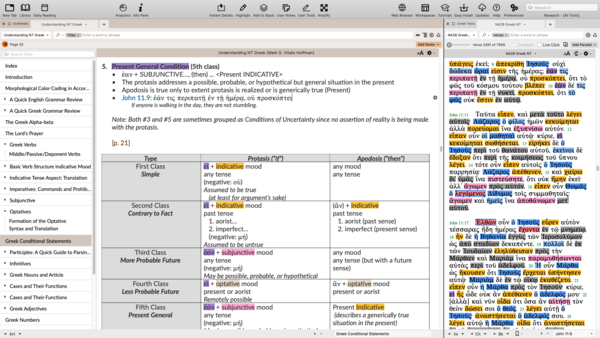Note: We are pleased to announce the immediate release of Understanding New Testament Greek by Mark G. Vitalis Hoffman. Rather than have us describe this phenomenally unique resource (designed specifically to work with Accordance) ourselves, we thought we’d let Dr. Hoffman tell you about this work himself.
 Understanding New Testament Greek: A new and straightforward way to acquire Greek language skills quickly
Understanding New Testament Greek: A new and straightforward way to acquire Greek language skills quickly
Mark G. Vitalis Hoffman
There was a time when the typical language requirement for Master of Divinity students was two years of Koine Greek plus a year of Hebrew followed by expectations of using the languages in exegetical classes. For Greek, the goal was to teach students how to read the Greek New Testament. Experience showed that not many students actually achieved that level of competence. Further, it takes ongoing practice to retain and expand one’s reading ability. The unfortunate result was that most pastors had forgotten their Greek and no longer used it in a couple years after seminary.
Meanwhile, changing curriculum requirements often reduced the language requirements to the point where some institutions have no language requirements at all. At the same time, however, incredible advances were being made in Bible software capabilities. What formerly took many books and the tedious process of paging through them was now accessible simply with the click of a mouse button.
This Understanding New Testament Greek grammar is the culmination of these factors in my teaching experience. It was developed out of necessity as a way to teach Greek in one semester. The goal, however, is not to read Greek but, as the title states, to understand Greek. There is very little memorization of vocabulary that is expected, since the software can easily provide the lexical information. The only paradigms students are encouraged to memorize are those of the Greek article and forms of the verb εἰμί. The software provides all the analysis. The focus is on understanding Greek grammar and syntax and becoming proficient in using the tools and resources available in the software.
If one steps back for a moment, the wisdom of such an approach becomes apparent. Unless a student ends up in advanced Greek studies, it is unreasonable to expect that they are going to come up with an English translation that is superior to one that committees of scholars have produced in the many standard versions now available. What students can do, however, is understand why a translation renders in a certain way. Further, they should be able to compare English versions, assess why there are differences, and make decisions on preferred renderings. Approaching Greek this way is a skill that is more easily retained and can be used throughout a ministry career than trying to maintain the ability to read Greek. Learning the software also provides them with the tools and resources to do a wide variety of secondary research.
Understanding New Testament Greek comes with a special highlighting file, available on the Accordance Exchange, for anyone to download.
How can the Bible software be leveraged to make understanding Greek possible in a semester’s worth of work? Understanding New Testament Greek accomplishes this by using a color coding system applied to the Greek text (GNT28-T) and in the grammar. For example, most Greek sentences have an indicative verb which appears with gold highlighting in the text. To learn about the possible nuances of translating the different Greek indicative tenses, one consults the gold section of the grammar. Similarly, infinitives are highlighted in green in the text, and one consults the green section of the grammar to identify all the syntactical functions of infinitives in Greek and determine what is the function and how to render it in any particular context. Highlighting is provided for nominative nouns and pronouns (to help locate the subject of a sentence), participles, subjunctive verbs, imperatives, conditional constructions, and prepositions with their objects.
The value of this approach is quickly evident to students.
- The color coding makes it easier to visualize the structure of the Greek.
- The color coding provides a visual way to reference the information needed in the grammar.
- They work with the New Testament Greek text from the beginning. There is no need for made-up simplified sentences.
- They are equipped to compare and evaluate various English translations.
- They are trained to use the range of resources available in the Bible software.
- Studying a Greek text ‘feels doable’ in that it does not require huge commitments of time to get through a verse, and it is a skill that can be applied over a ministry career.
This grammar is intended as a reference grammar, but I have also used it as a teaching grammar. By the end of the second week, students have reviewed English and Greek grammar and are able to translate any Greek indicative verb. In the third week, nouns, the Greek article, and the function of cases is covered. One session covers all that is needed to know for infinitives and another one for imperatives. Subjunctives and conditional constructions get two sessions. Participles take three sessions to cover. That still leaves time to cover the remaining, finer points of Greek grammar.
Whether used for a class or by individuals, whether as an approach to the language or as a resource to more efficiently study the text, Understanding New Testament Greek is a wonderful and colorful (!) resource to use.
Understanding New Testament Greek
Regular Price $19.90
Note: The highlight file (UnderstandingNTG2) used with this product works with the Greek New Testament (tagged, based on NA28) (GNT28-T). It does not highlight any other Greek text.
Mark G. Vitalis Hoffman, Glatfelter Professor of Biblical Studies at United Lutheran Seminary, has over 20 years of experience teaching Greek. He has been a leader in using technology in the service of seminary education. (Cf. his Biblical Studies and Technological Tools blog.)


